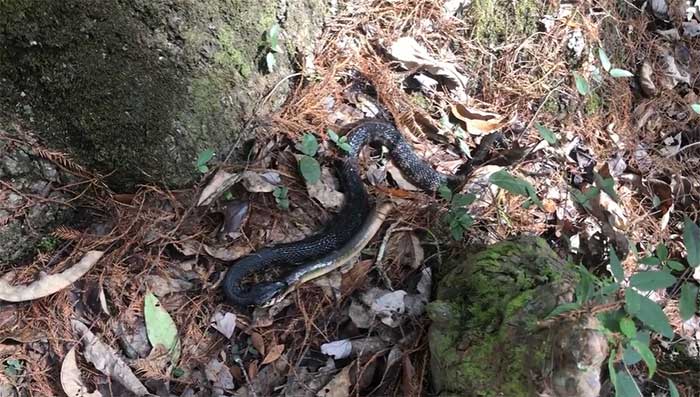The Southern Watersnake slowly swallows a slippery American Eel, despite the prey’s repeated struggles to escape.
(Video: DNR)
The struggle between a dark-colored snake and an eel of similar size was captured and shared by the Wildlife Resources Division of the Georgia Department of Natural Resources (DNR) on Facebook on December 1. “One of our biologists encountered the predatory snake in a swamp in Liberty County last week. The Southern Watersnake was wrestling with an American Eel. Both animals thrashed around in the shallow water,” DNR reported.

The Southern Watersnake gradually swallowing the eel.
The Southern Watersnake (Nerodia fasciata) inhabits the southern and southeastern states of the United States, found in nearly all freshwater environments including ponds, lakes, rivers, streams, and swamps. They can grow to lengths of 60 to 107 cm, with the longest specimens reaching about 158 cm. Named for their characteristic stripes on their backs, these stripes may be less distinct if the snake is dark in color, and their skin darkens with age. Southern Watersnakes primarily feed on fish and amphibians. They utilize a sensory organ known as Jacobson’s organ to detect prey through the identification of a specific protein called parvalbumin found in the mucus of amphibians and certain fish.
The American Eel (Anguilla rostrata) is among the prey of the Southern Watersnake. As the only freshwater eel species in North America, they have a complex life cycle, primarily residing in rivers and estuaries but migrating to the Sargasso Sea off the eastern United States to spawn. Young eels hatch in the Sargasso Sea before drifting with ocean currents for a year. They then make their way to the eastern shores of the United States, swimming into rivers and estuaries to mature. Upon reaching spawning age, they migrate back and die in the Sargasso Sea.
The American Eel is listed as an endangered species by the International Union for Conservation of Nature (IUCN). They can grow longer than 1.2 meters and are covered in a thick layer of mucus. Mature eels are often preyed upon by birds, larger fish, or larger eels.
Researchers are still uncertain whether Southern Watersnakes frequently prey on American Eels. Despite the sizeable meal, the snake in the video managed to swallow the entire body of the eel, according to DNR.


















































